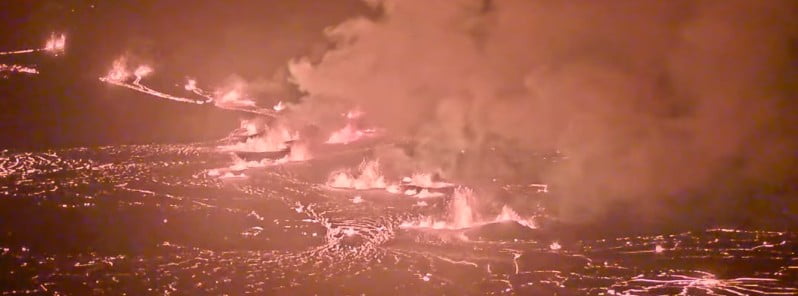Rapid uplift and strong seismicity precede new eruption at Kīlauea, Hawaii

At 01:15 UTC on September 11, 2023 (15:15 HST, September 10), the USGS Hawaiian Volcano Observatory (HVO) identified new eruptive activity at Kīlauea’s summit within Hawai‘i Volcanoes National Park, based on webcam images and field reports. The eruption was preceded by intense seismic activity and rapid uplift at the summit.
Eruptive activity commenced within the Halemaʻumaʻu crater and on the adjacent down dropped block to the east in Kīlauea’s summit caldera. HVO is keeping a close watch, given the dynamic nature of the eruption’s opening phases.
Webcam visuals confirm fissures at Halemaʻumaʻu crater’s base, spewing lava flows across the crater floor. The current activity remains limited to Halemaʻumaʻu, with potential hazards being re-evaluated as the situation unfolds.
The USGS Hawaiian Volcano Observatory elevated Kīlauea’s volcano alert level from Watch to Warning, also changing its aviation color code from Orange to Red. These adjustments stem from the urgency to assess the eruption and the related dangers it poses.
The hazard analysis carried out revealed that the eruptive activities are contained within a section of Hawai’i Volcanoes National Park that is closed to the public. Primary volcanic gas hazards have been pinpointed as high concentrations of water vapor (H2O), carbon dioxide (CO2), and sulfur dioxide (SO2). The continuous release of SO2 during the eruption is anticipated to react in the atmosphere, leading to the formation of vog (volcanic smog) that will drift downwind of Kīlauea. Vital information about vog can be accessed at https://vog.ivhhn.org/.
Moreover, additional threats are posed by the fallout of Pele’s hair and other lightweight volcanic glass shards resulting from the lava fountains. These fragments are expected to settle downwind of the fissure vents, blanketing the ground within several hundred meters/yards. It’s recommended that locals and tourists limit exposure to these volcanic particles to avoid potential skin and eye irritations.
Furthermore, the region around Kīlauea caldera, particularly near the Halemaʻumaʻu crater, remains dangerous due to wall instability, ground fissures, and potential rockfalls. These hazards may be exacerbated by tremors in the vicinity that is off-limits to visitors. The Kīlauea caldera rim, which encompasses the Halemaʻumaʻu crater, has been declared a no-go zone for the public since the end of 2007.
Live view of the eruption in Halemaʻumaʻu, from the northwest rim of the caldera, looking east [V1cam]:
References:
1 HVO/USGS Volcanic Activity Notice for Kilauea (VNUM #332010) – Sunday, September 10, 2023, 3:18 PM HST
Featured image credit: USGS/HVO. Acquired at 08:02 UTC on September 11, 2023


Commenting rules and guidelines
We value the thoughts and opinions of our readers and welcome healthy discussions on our website. In order to maintain a respectful and positive community, we ask that all commenters follow these rules.